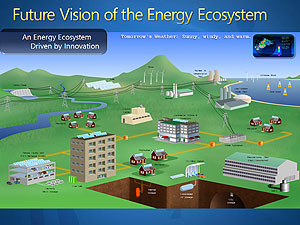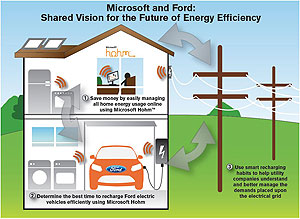REDMOND, Wash. – May 24, 2010 – Power grids aren’t often the subject of heated debate. Most consumers don’t think about electricity unless it fails. But today’s rising prices and environmental concerns have put a bright spotlight on power – how it’s made, marketed, used.

As businesses and consumers adopt new alternative energy technologies, the service ecosystem will be complex and highly distributed.
Now, people are asking some compelling questions. What if the power grid could do more to conserve energy and lower costs? Could consumers remotely control household appliances to improve their efficiency? Will utilities be able to shift more of their load to renewable energy sources?
One possible way to achieve these goals is through the “smart grid” – a term that’s often heard these days, but not always well understood. In essence, a smart grid uses digital technology so that an energy grid does much more than simply deliver megawatts on demand.
A traditional power grid is disconnected, largely mechanical, and focuses strictly on getting power from the plant to users. A traditional power grid is so dumb, in fact, that when a tree falls on power lines or lightning hits a transformer, consumers are the first to report the outage. Only then will a power company dispatch a truck to locate and repair the problem.
A smart grid creates a more intelligent energy ecosystem that connects every piece – from the solar farm or power plant all the way to the home. It knows where an outage is — and possibly identifies and fixes the problem before it even happens. The smart grid also could lead to widespread use of smart meters, home energy-management systems, and programmable thermostats.
Digital technology is what makes the grid smart. Its role is similar to how retail stores have evolved from places where clerks keyed in prices and did manual inventory counts, to the use of scanning to trigger real-time manufacturing based on purchases so the product is always on the shelf. As technology connects utilities across electricity generation, transmission, distribution – and soon consumption – more information will be available throughout the entire ecosystem. In a smart grid environment, utilities can capture data to determine when demand peaks occur. Then, they can adjust generation to compensate and avoid overloading the grid and prevent outages.
Today’s Consumer Wants Control
Smart grid technologies also give consumers more control over daily decisions affecting their wallets. After all, says Jon Arnold, who leads the Worldwide Power & Utilities Industry for Microsoft, consumers have control in banking, healthcare and retail. Why not when and how they purchase energy?
Suppose you forget to turn the lights off at home. The capability is already available to turn them off with your cell phone. And soon, people who drive electric or hybrid vehicles will be able to program their vehicle rechargers to only draw current during off-peak hours, when power is more available and less expensive.
“People like control over their household energy usage, but they’re busy and don’t want to spend massive amounts of time managing it. The value is making control not just easy, but also transparent,” Arnold says.

An alliance between Ford Motor Co. and Microsoft will enable Microsoft Hohm, an Internet-based service, to help electric vehicle owners optimize their vehicle recharging needs and better manage their home’s energy use. Hohm can also help utilities understand and better manage the rise in energy demand expected from the surge in electric vehicle ownership.
Here’s how a smart grid might help individual consumers. People willing to complete a short online profile could set preferences for how they want their house to respond to pricing. These might include options such as when and how their utility should contact them with time-of-use rate options that can save them money. Then they receive a brief weekly e-mail summary and can make quick adjustments from their cell phone, car or PC. For the first time, this piece connects the home with the rest of the smart energy ecosystem, starting with where power is originally generated.
In addition to being transparent, the in-home piece needs to be easy to use. Utilities count on technology companies to develop new capabilities in a way people will want to use. For example, home energy management is a booming market. Go to Bing and search on “home energy management” to see the multitude of hardware and software choices consumers have today.
One choice gaining in popularity is Microsoft Hohm, a free home energy management application that helps consumers save energy and money. Hohm uses advanced analytics to give consumers personalized energy saving recommendations based on basic home facts they provide. Consumers can also compare their energy usage with others in their area and connect with others for energy- and money-saving ideas.
“As people make smarter decisions about energy use at home, the collective change in consumer behavior has a positive impact,” says Arnold. “Hohm provides valuable information utilities use to better manage demand and help consumers use less energy.”
Smart Technologies Help Utilities Deliver Cleaner Fuel More Efficiently
With demand for electricity expected to increase 30 percent by 2030, according to the Electric Power Research Institute, utilities are keen to take advantage of the help that smart grids can provide.
Today, while most utilities have their eye on smart grid development, each is at a different point in the journey. So they look to their technology partners such as Microsoft, Alstom, Areva, Itron and OSIsoft to provide specialized technology and services from automation and systems integration to ways to manage and use the data that smart meters produce. Technology partners have the tools to help manage and store cleaner energy such wind and solar, to manage the way energy is distributed, and to help prepare for new emissions regulations. Utilities also look to technology to help improve customer relationships and meet the growing demand. Microsoft’s Worldwide Utility Industry Survey 2010 shows that 57 percent of the respondents think information technologies today are not sufficient to address future challenges. So change is certain.
Idaho Power Company, for example, envisions using data analysis and information that smart technology helps provide to potentially influence its own and consumers’ behavior. “By analyzing customer usage patterns, we can assess potential rate structures, for example, and provide consumers more choices,” says Mark Heintzelman, AMI project manager for Idaho Power. “This will make customers happier and help us both conserve.”
Utilities also count on technology partners to help ensure their technology infrastructure has the connectivity and information access their employees need to work together in the smart energy ecosystem. U.S. federal stimulus money has enabled many projects to move from concept to reality.
One big area of work, says Microsoft’s Arnold, is in integrating renewable energy resources with existing ones. Microsoft’s survey also reveals that 42 percent of the responding utilities are currently incorporating distributed generation sources such as wind and solar on rooftops and another 25 percent will begin to incorporate these sources in the next one to three years. These renewable sources are not consistent, so technology can help utilities manage their full portfolio of resources “to maximize the supply of renewables balanced against existing generation sources—all while keeping the grid balanced and our lights on,” Arnold says.
Utilities worldwide are adding technology capabilities to handle a world of renewables, new regulations, and even consumers who generate their own energy. But utilities have no intention of replacing everything. By connecting their business processes, systems, software, human interaction and assets, they’ll be able to do many things they’ve never done before. They’ll be able to more easily gather CO2 data needed for new emissions reports, get the wind power from the prairies to the cities and better manage energy demand overall.
Along with the good, some say smart grid technology has gotten off to a rocky start – especially with smart meters, which in some cases have been blamed for higher utility bills. But “with collaboration among utilities, technology companies and other stakeholders, we’ll learn and move past these challenges to all benefit from new capabilities,” Arnold says.
And we have to. “If you look 10 to 20 years into the future, the energy ecosystem will be far more complex than what we have today. And the next 100 years will make putting men on the moon seem like child’s play,” says Arnold.




